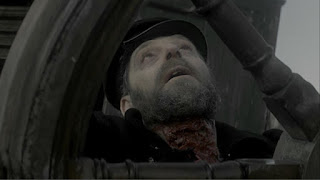
Tod Browning's Dracula (1931) is a pivotal movie in the history of horror movies. It is the first major horror film of the sound era. Without its success, the explosion of horror movies during the pre-Code era possibly doesn't happen, or, maybe, happens on a smaller scale or just differently. The movie studios of the day, big and small, were increasingly desperate for hits in 1931 as the Great Depression deepened and paying audiences evaporated. Anything that drew a crowd was all right by the heads of the studios. What drew crowds in those days was sin, salaciousness, violence, licentiousness, and sensation. Horror movies could provide all of that. The genre itself is built on transgression, after all. Moreover, the elements of what came to be defined as the Universal horror movie were already in place. Universal made big money on horror movies during the silent era. Two of Lon Chaney's biggest hits--The Hunchback of Notre Dame (1923) and The Phantom of the Opera (1926)--were made at Universal, as was the John Barrymore version of Dr. Jekyll and Mr. Hyde (1920). Universal was also the landing spot for Paul Leni, the German director who had huge success for Universal with The Cat and the Canary (1927) and The Man Who Laughs (1928). So Universal, at least, was already in the horror movie business before Dracula.
Carl Laemmle, Sr., the company's founder, did not want to make Dracula. He thought it was essentially demonic, unlike the studio's previous horror films, which he viewed as essentially humanist. Carl Laemmle, Jr., however was keen on the property and only convinced his father to buy the rights to the play because MGM was ready to step in if Universal passed on it. It is likely that an MGM production would not have been very different from what Universal eventually made. Tod Browning was under contract to MGM, after all. Universal had to borrow him for their film. Browning for his part wanted Dracula long before Universal took an interest. He had already discussed the possibility with Lon Chaney. Chaney had already worked up a make-up look for The Count. He wanted it as much as Browning. Other filmmakers at Universal wanted Dracula, too. Paul Leni was keen to make Dracula with HIS frequent collaborator, Conrad Veidt, in the role. In some alternate universe, such a picture is one of the masterpieces of the genre. Veidt might even have made the film had he not gone back to Europe at the time, afraid that his thick accent would be a hindrance to his American movie career. If he only knew... Two things conspired to shape the film that was ultimately made: Leni died of blood poisoning in September of 1929. Chaney died of lung cancer in August of 1930. Without Chaney, MGM lost interest in the property. Browning, without a star for the project, decided to cast the relatively unknown Hungarian actor, Bela Lugosi, in the part. He had worked with Lugosi once before in The Thirteenth Chair (1929). Lugosi had drawn crowds to the theatrical version by Hamilton Deane and John L. Balderston on the stage and had a much publicized dalliance with Clara Bow, so he wasn't obscure, exactly. Just obscure in movies. The match was made and Dracula went into production on September 30, 1930.













































